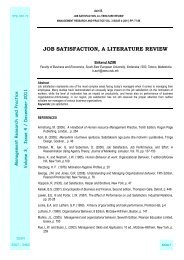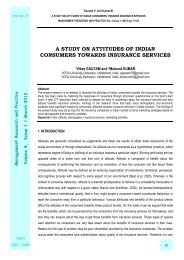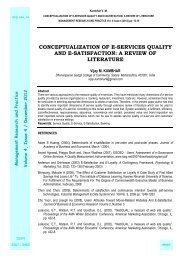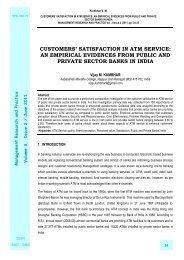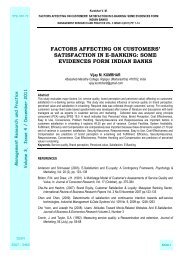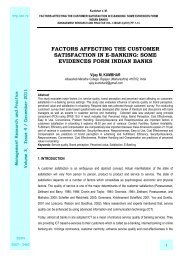the swot analysis of the romanian health care system - Management ...
the swot analysis of the romanian health care system - Management ...
the swot analysis of the romanian health care system - Management ...
You also want an ePaper? Increase the reach of your titles
YUMPU automatically turns print PDFs into web optimized ePapers that Google loves.
mrp.ase.ro<br />
Cicea C., Busu C. and Armeanu E.<br />
THE SWOT ANALYSIS OF THE ROMANIAN HEALTH CARE SYSTEM AND THE KEY ELEMENTS FOR<br />
RESOURCES ALLOCATION<br />
MANAGEMENT RESEARCH AND PRACTICE Vol. 3 Issue 3 (2011) pp. 32-41<br />
<strong>Management</strong> Research and Practice<br />
Volume 3, Issue 3 / September 2011<br />
1.Recoil <strong>of</strong> socialeconomical<br />
determinants<br />
2.Unreasonable<br />
<strong>health</strong> <strong>care</strong><br />
behaviour related<br />
to <strong>health</strong> risk<br />
factors<br />
3.Poor environmental<br />
conditions<br />
TABLE 1 - THE OPPORTUNITIES AND THREATS OF THE ROMANIAN MEDICAL SYSTEM<br />
THREATS - OPPORTUNITIES<br />
1.Major determinants <strong>of</strong> <strong>health</strong> condition<br />
a) Although Romania amounts about 6% <strong>of</strong> <strong>the</strong> total EU inhabitants (15), only produces 1.5%<br />
<strong>of</strong> GDP (PPS) <strong>of</strong> UE.<br />
b) The <strong>analysis</strong> <strong>of</strong> <strong>the</strong> human development index (HDI) in Romania, during 1990-2009, reveals<br />
important differences, not only against <strong>the</strong> countries within EU (15), but as well against <strong>the</strong> last<br />
10 countries that have accessed (0.778 in 2009 at Romania level, as compared to index<br />
between 0.936 and 0.946 in EU-15 and between 0.895 and 0.850 in countries such as Slovenia,<br />
Cyprus, Malta, Poland).<br />
c) As compared to <strong>the</strong> EU average (15), Romania distinguishes itself by a high share <strong>of</strong><br />
people aged between 25-64 and with an average education level: 60.9% against 43% (UE<br />
average-15); but in Romania, <strong>the</strong> segment <strong>of</strong> population aged between 25-64, with a higher<br />
education level, only amounts to 9.6%, as compared to <strong>the</strong> same share on <strong>the</strong> EU assembly -<br />
15 <strong>of</strong> 21%.<br />
d) Employment indicators in Romania highlight <strong>the</strong> existing difference against those registered<br />
by EU-15.<br />
a) Tobaccoism incidence has mainly increase on male segment, as Romania distinguishes by<br />
a cigarette consumption (62% <strong>of</strong> <strong>the</strong> adult population in 2009), highly exceeding <strong>the</strong> EU<br />
countries average (where <strong>the</strong> range <strong>of</strong> this share varies between 19% - Sweden and 47% -<br />
Greece).<br />
b) The average yearly consumption <strong>of</strong> certain foods that can impair <strong>health</strong> show for<br />
Romania an alarming deterioration <strong>of</strong> people nutrition, having effects over <strong>the</strong> <strong>health</strong><br />
condition, mainly for deprived segments <strong>of</strong> population; it is noticed <strong>the</strong> tendency to increase<br />
consumption per inhabitant during 2000-2007, <strong>of</strong> all foods (not including sugar) considered<br />
risk factors that can harm <strong>health</strong>: calories from 2953 (year 2000) to 3233 (year 2007), alcohol<br />
from 8.9 l to 9.6 l, vegetable and animal fats from 14.3 kg to 17.2 kg.<br />
a) The huge difference Romania registers as compared to EU countries related to <strong>the</strong><br />
environmental conditions is emphasized by <strong>the</strong> very low share <strong>of</strong> population having access<br />
to a quality water source (58% in 2000) and quality sanitary installations (53% in 2000).<br />
b) Possible morbidity shocks, under <strong>the</strong> conditions <strong>of</strong> <strong>the</strong> powerful damage to <strong>the</strong> environment<br />
(acts <strong>of</strong> God) and <strong>of</strong> <strong>the</strong> urban decline (<strong>the</strong> absence <strong>of</strong> investments in utilities), marginalisation<br />
<strong>of</strong> <strong>the</strong> dropped behind areas<br />
4. Health promotion As opposed to UE, where a series <strong>of</strong> effective measures were taken, with visible results and<br />
retrieved as synergetic effect in reducing <strong>the</strong> morbidity and mortality degree <strong>of</strong> population, in<br />
Romania is it possible to assess that a conjugated action is required <strong>of</strong> all involved factors<br />
in ensuring <strong>the</strong> performance <strong>of</strong> <strong>the</strong> national <strong>health</strong> <strong>system</strong>, so much <strong>the</strong> more as morbidity<br />
rates have increased for <strong>the</strong> main contagious diseases (tuberculosis, syphilis, viral hepatitis...)<br />
5. KEY ELEMENTS FOR FINANCING OF THE HEALTHCARE SYSTEM<br />
The criteria used to select <strong>the</strong> most appropriate method for financing a <strong>health</strong><strong>care</strong> <strong>system</strong> tend to focus on<br />
<strong>the</strong> capacity <strong>of</strong> <strong>the</strong> aimed method <strong>of</strong> meeting six important elements (Blidu, 2006):<br />
<strong>the</strong> capacity to generate <strong>the</strong> required income;<br />
equity;<br />
efficiency;<br />
quality <strong>of</strong> services;<br />
sustainability.<br />
Unfortunately, it is impossible to equally meet <strong>the</strong>se objectives. Therefore, <strong>the</strong> policymakers have <strong>the</strong> task to<br />
perform a trade-<strong>of</strong>f between <strong>the</strong> six objectives listed, according to <strong>the</strong> features <strong>of</strong> <strong>the</strong> society.<br />
ISSN<br />
2067- 2462<br />
37



